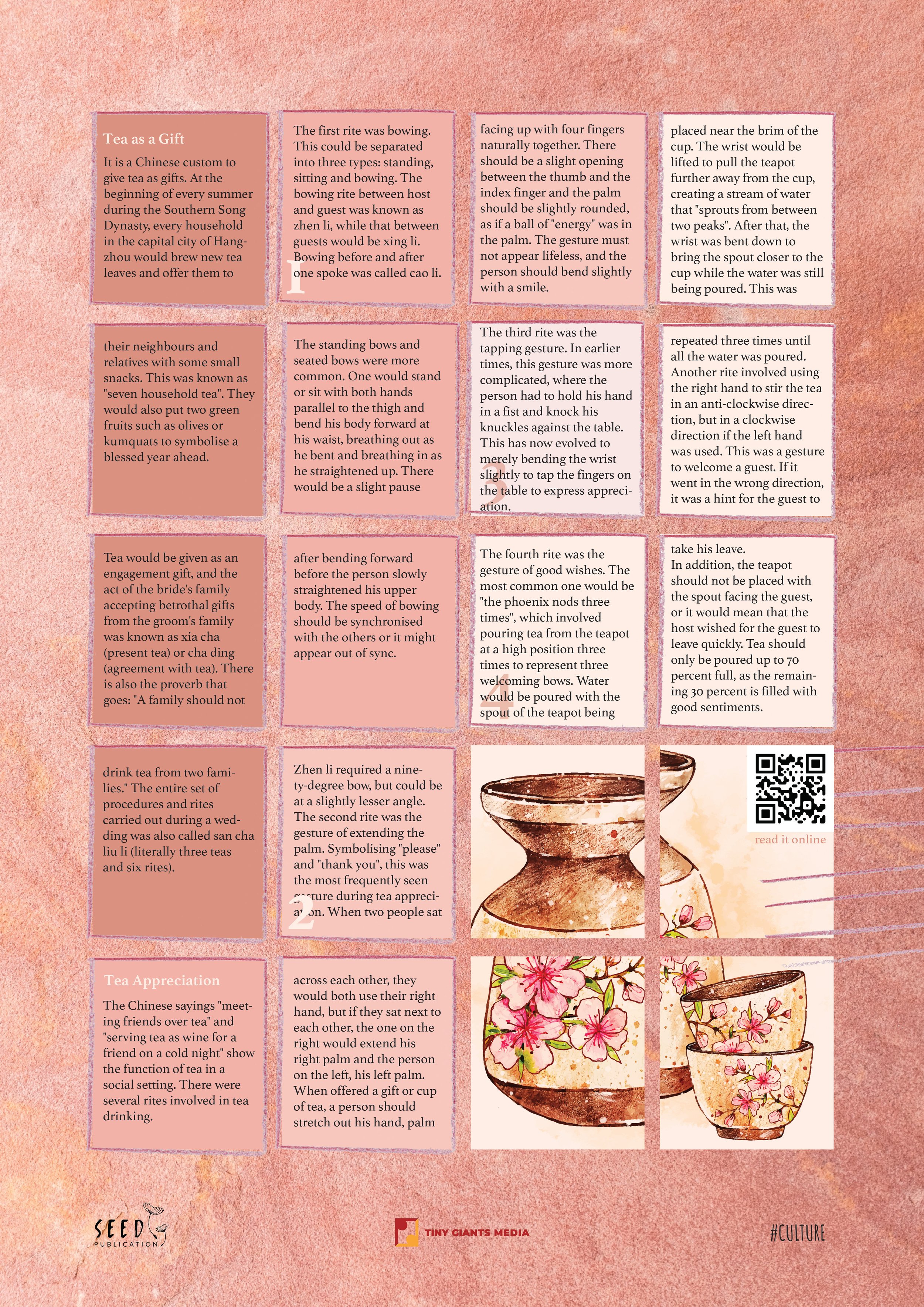Tea in Chinese Culture.

Tea as a gift.
It is a Chinese custom to give tea as gifts. At the beginning of every summer during the Southern Song Dynasty, every household in the capital city of Hangzhou would brew new tea leaves and offer them to their neighbours and relatives with some small snacks. This was known as "seven household tea". They would also put two green fruits such as olives or kumquats to symbolise a blessed year ahead.
Tea would be given as an engagement gift, and the act of the bride's family accepting betrothal gifts from the groom's family was known as xia cha (present tea) or cha ding (agreement with tea). There is also the proverb that goes: "A family should not drink tea from two families." The entire set of procedures and rites carried out during a wedding was also called san cha liu li
(literally three teas and six rites).
Tea Appreciation.
The Chinese sayings "meeting friends over tea" and "serving tea as wine for a friend on a cold night" show the function of tea in a social setting. There were several rites involved in tea drinking.
The first rite was bowing. This could be separated into three types: standing, sitting and bowing. The bowing rite between host and guest was known as zhen li, while that between guests would be xing li. Bowing before and after one spoke was called cao li. The standing bows and seated bows were more common. One would stand or sit with both hands parallel to the thigh and bend his body forward at his waist, breathing out as he bent and breathing in as he straightened up. There would be a slight pause after bending forward before the person slowly straightened his upper body. The speed of bowing should be synchronised with the others or it might appear out of sync.
Zhen li required a ninety-degree bow, but could be at a slightly lesser angle.
The second rite was the gesture of extending the palm. Symbolising "please" and "thank you", this was the most frequently seen gesture during tea appreciation. When two people sat across each other, they would both use their right hand, but if they sat next to each other, the one on the right would extend his right palm and the person on the left, his left palm. When offered a gift or cup of tea, a person should stretch out his hand, palm facing up with four fingers naturally together. There should be a slight opening between the thumb and the index finger and the palm should be slightly rounded, as if a ball of "energy" was in the palm. The gesture must not appear lifeless, and the person should bend slightly with a smile.
The third rite was the tapping gesture. In earlier times, this gesture was more complicated, where the person had to hold his hand in a fist and knock his knuckles against the table. This has now evolved to merely bending the wrist slightly to tap the fingers on the table to express appreciation.
The fourth rite was the gesture of good wishes. The most common one would be "the phoenix nods three times", which involved pouring tea from the teapot at a high position three times to represent three welcoming bows. Water would be poured with the spout of the teapot being placed near the brim of the cup. The wrist would be lifted to pull the teapot further away from the cup, creating a stream of water that "sprouts from between two peaks". After that, the wrist was bent down to bring the spout closer to the cup while the water was still being poured. This was repeated three times until all the water was poured. Another rite involved using the right hand to stir the tea in an anti-clockwise direction, but in a clockwise direction if the left hand was used. This was a gesture to welcome a guest. If it went in the wrong direction, it was a hint for the guest to take his leave.
In addition, the teapot should not be placed with the spout facing the guest, or it would mean that the host wished for the guest to leave quickly. Tea should only be poured up to 70 percent full, as the remaining 30 percent is filled with good sentiments.
More like that:

Natural emotion gone bad and how to detect it.
Chinese Fairy Tales and Fantasies.
A story from a Japanese folktale collection.
An old story about anger and self-control.




























